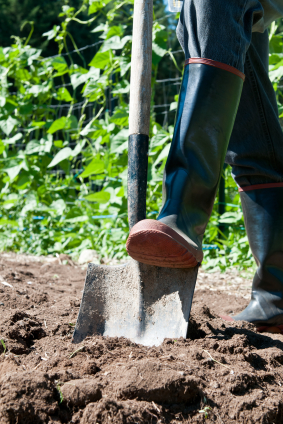Protect yourself with Asgard garden storage
Garden Accidents
Before any major physical exertion such as digging the veg plot or laying a new patio, dosome limbering up exercises to help avoid unnecessary back and muscle strain
With spring just around the corner and the gardening bug about to bite us all again,Hospital A&E departments will be waiting with baited breath for the firstof this year's gardening accidents.
According to the Royal Society for the Prevention of Accidents (ROSPA - www.rospa.com ),using their historical statistics, around 300,000 people will be injured in their gardens this year, with over 100,000 of these being children. Their top ten list of the most dangerous tools is:
1.Lawnmowers (6,500 accidents per annum)
2.Flower pots (5,300)
3. Secateurs and pruners (4,400)
4. Spades(3,600)
5. Electric hedge trimmers (3,100)
6. Planttubsand troughs (2,800)
7. Shears(2,100)
8. Garden forks (2,000)
9. Hoses and sprinklers (1,900)
10. Garden canes and sticks (1,800).
It does not take a rocket scientist to work out, with each category, what might have happened in the garden to turn those people into accident statistics.
The fact is that, as we rush and tear around in our ever busier lives, never stopping to draw breath between one activity and another, we are likely to miss or forget things and these statistics develop accordingly.

I cannot find any information about the financial implications of these accidents,either for the individual, the family or for the National Health Service but,using the rocket scientist analogy again, it does not take one to work out themillions of pounds lost or spent.
Check all electrical equipment before you plug it in and check the RCD (Residual Current Device) is functional, whether this is on the whole property or through aplug-in device. Do not use electrical equipment in wet weather.
Always switch off any petrol or electrical equipment before carrying out any maintenance on it.
Only use ladders or steps if it is really necessary and have someone with you to support the ladder or steps whilst you are working.
Wear suitable clothing for each job, sandals and mowers do not go together!! Gloves, goggles, stout boots and even ear defenders may be necessary with some equipment.
Keep all sharp tools and equipment locked away from children while they are not in useand do not let children 'have a go '.
Before any major physical exertion such as digging the veg plot or laying a new patio, dosome limbering up exercises to help avoid unnecessary back and muscle strain - do this indoors if you think that your neighbours might be watching.
Keep all chemical products locked away from children at all times or grow organic and remove all chemicals from your garden shed.
Keep all pathways and access points clear of trip hazards at all times and, if the garden is to be used at night, ensure that all possible hazards are removed and that the area is well lit.
If you buy a new piece of garden equipment, read the instructions carefully and do not useuntil you are certain that you fully understand the operation of the equipment.
Lastly, but by no means least, never work in the garden when you are tired as this can makeyou forgetful, careless and clumsy.
So, lets hope that you do not become one of the accident statistics in the garden and, if you want to follow this subject a little further, why not visit the BBC Gardening website at www.bbc.co.uk/gardening or take a look at www.which.co.uk(Garden equipment reports including how safe they are), www.gardenguide.biz or www.diynot.com












